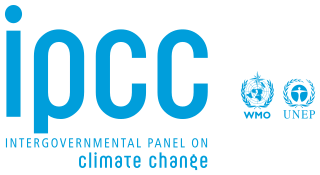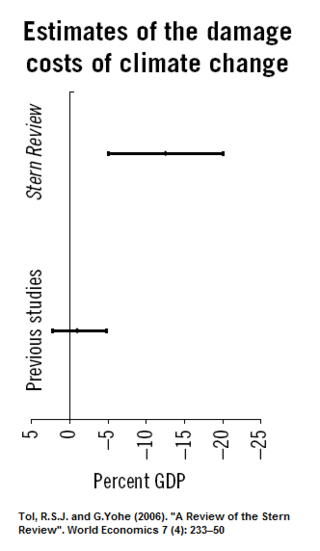Related Research Articles

Climate is the long-term weather pattern in a region, typically averaged over 30 years. More rigorously, it is the mean and variability of meteorological variables over a time spanning from months to millions of years. Some of the meteorological variables that are commonly measured are temperature, humidity, atmospheric pressure, wind, and precipitation. In a broader sense, climate is the state of the components of the climate system, including the atmosphere, hydrosphere, cryosphere, lithosphere and biosphere and the interactions between them. The climate of a location is affected by its latitude, longitude, terrain, altitude, land use and nearby water bodies and their currents.

Nuclear winter is a severe and prolonged global climatic cooling effect that is hypothesized to occur after widespread firestorms following a large-scale nuclear war. The hypothesis is based on the fact that such fires can inject soot into the stratosphere, where it can block some direct sunlight from reaching the surface of the Earth. It is speculated that the resulting cooling would lead to widespread crop failure and famine. When developing computer models of nuclear-winter scenarios, researchers use the conventional bombing of Hamburg, and the Hiroshima firestorm in World War II as example cases where soot might have been injected into the stratosphere, alongside modern observations of natural, large-area wildfire-firestorms.

Stephen Henry Schneider was Professor of Environmental Biology and Global Change at Stanford University, a Co-Director at the Center for Environment Science and Policy of the Freeman Spogli Institute for International Studies and a Senior Fellow in the Stanford Woods Institute for the Environment. Schneider served as a consultant to federal agencies and White House staff in the Richard Nixon, Jimmy Carter, Ronald Reagan, George H. W. Bush, Bill Clinton, George W. Bush and Barack Obama administrations.

The sulfate or sulphate ion is a polyatomic anion with the empirical formula SO2−4. Salts, acid derivatives, and peroxides of sulfate are widely used in industry. Sulfates occur widely in everyday life. Sulfates are salts of sulfuric acid and many are prepared from that acid.

A general circulation model (GCM) is a type of climate model. It employs a mathematical model of the general circulation of a planetary atmosphere or ocean. It uses the Navier–Stokes equations on a rotating sphere with thermodynamic terms for various energy sources. These equations are the basis for computer programs used to simulate the Earth's atmosphere or oceans. Atmospheric and oceanic GCMs are key components along with sea ice and land-surface components.

Global dimming was the name given to a decline in the amount of sunlight reaching the Earth's surface, a measure also known as global direct solar irradiance. It was observed soon after the first systematic measurements of solar irradiance began in the 1950s, and continued until 1980s, with an observed reduction of 4–5% per decade, even though solar activity did not vary more than the usual at the time. Instead, global dimming had been attributed to an increase in atmospheric particulate matter, predominantly sulfate aerosols, as the result of rapidly growing air pollution due to post-war industrialization. After 1980s, global dimming started to reverse, alongside reductions in particulate emissions, in what has been described as global brightening, although this reversal is only considered "partial" for now. This reversal has also been globally uneven, as some of the brightening over the developed countries in the 1980s and 1990s had been counteracted by the increased dimming from the industrialization of the developing countries and the expansion of the global shipping industry, although they have also been making rapid progress in cleaning up air pollution in the recent years.

The Special Report on Emissions Scenarios (SRES) is a report by the Intergovernmental Panel on Climate Change (IPCC) that was published in 2000. The greenhouse gas emissions scenarios described in the Report have been used to make projections of possible future climate change. The SRES scenarios, as they are often called, were used in the IPCC Third Assessment Report (TAR), published in 2001, and in the IPCC Fourth Assessment Report (AR4), published in 2007. The SRES scenarios were designed to improve upon some aspects of the IS92 scenarios, which had been used in the earlier IPCC Second Assessment Report of 1995. The SRES scenarios are "baseline" scenarios, which means that they do not take into account any current or future measures to limit greenhouse gas (GHG) emissions.

An abrupt climate change occurs when the climate system is forced to transition at a rate that is determined by the climate system energy-balance. The transition rate is more rapid than the rate of change of the external forcing, though it may include sudden forcing events such as meteorite impacts. Abrupt climate change therefore is a variation beyond the variability of a climate. Past events include the end of the Carboniferous Rainforest Collapse, Younger Dryas, Dansgaard–Oeschger events, Heinrich events and possibly also the Paleocene–Eocene Thermal Maximum. The term is also used within the context of climate change to describe sudden climate change that is detectable over the time-scale of a human lifetime, possibly as the result of feedback loops within the climate system or tipping points.

The economic analysis of climate change explains how economic thinking, tools and techniques are applied to calculate the magnitude and distribution of damage caused by climate change. It also informs the policies and approaches for mitigation and adaptation to climate change from global to household scales. This topic is also inclusive of alternative economic approaches, including ecological economics and degrowth. In a cost–benefit analysis, the trade offs between climate change impacts, adaptation, and mitigation are made explicit. Cost–benefit analyses of climate change are produced using integrated assessment models (IAMs), which incorporate aspects of the natural, social, and economic sciences. The total economic impacts from climate change are difficult to estimate, but increase for higher temperature changes.
Integrated assessment modelling (IAM) or integrated modelling (IM) is a term used for a type of scientific modelling that tries to link main features of society and economy with the biosphere and atmosphere into one modelling framework. The goal of integrated assessment modelling is to accommodate informed policy-making, usually in the context of climate change though also in other areas of human and social development. While the detail and extent of integrated disciplines varies strongly per model, all climatic integrated assessment modelling includes economic processes as well as processes producing greenhouse gases. Other integrated assessment models also integrate other aspects of human development such as education, health, infrastructure, and governance.

The Potsdam Institute for Climate Impact Research is a German government-funded research institute addressing crucial scientific questions in the fields of global change, climate impacts, and sustainable development. Ranked among the top environmental think tanks worldwide, it is one of the leading research institutions and part of a global network of scientific and academic institutions working on questions of global environmental change. It is a member of the Leibniz Association, whose institutions perform research on subjects of high relevance to society.

Solar geoengineering, or solar radiation modification (SRM), is a type of climate engineering in which sunlight would be reflected back to outer space to limit or offset human-caused climate change. There are multiple potential approaches, with stratospheric aerosol injection (SAI) being the most-studied method, followed by marine cloud brightening (MCB). Other methods have been proposed, including a variety of space-based approaches, but they are generally considered less viable, and are not taken seriously by the Intergovernmental Panel on Climate Change. SRM methods could have a rapid cooling effect on atmospheric temperature, but if the intervention were to suddenly stop for any reason, the cooling would soon stop as well. It is estimated that the cooling impact from SAI would cease 1–3 years after the last aerosol injection, while the impact from marine cloud brightening would disappear in just 10 days. Contrastingly, once any carbon dioxide is added to the atmosphere and not removed, its warming impact does not decrease for a century, and some of it will persist for hundreds to thousands of years. As such, solar geoengineering is not a substitute for reducing greenhouse gas emissions but would act as a temporary measure to limit warming while emissions of greenhouse gases are reduced and carbon dioxide is removed.
The Copenhagen Accord is a document which delegates at the 15th session of the Conference of Parties to the United Nations Framework Convention on Climate Change agreed to "take note of" at the final plenary on 18 December 2009.

Climate change scenarios or socioeconomic scenarios are projections of future greenhouse gas (GHG) emissions used by analysts to assess future vulnerability to climate change. Scenarios and pathways are created by scientists to survey any long term routes and explore the effectiveness of mitigation and helps us understand what the future may hold. This will allow us to envision the future of human environment system. Producing scenarios requires estimates of future population levels, economic activity, the structure of governance, social values, and patterns of technological change. Economic and energy modelling can be used to analyze and quantify the effects of such drivers.

A Representative Concentration Pathway (RCP) is a greenhouse gas concentration trajectory adopted by the IPCC. Four pathways were used for climate modeling and research for the IPCC Fifth Assessment Report (AR5) in 2014. The pathways describe different climate change scenarios, all of which are considered possible depending on the amount of greenhouse gases (GHG) emitted in the years to come. The RCPs – originally RCP2.6, RCP4.5, RCP6, and RCP8.5 – are labelled after a possible range of radiative forcing values in the year 2100. The higher values mean higher greenhouse gas emissions and therefore higher global temperatures and more pronounced effects of climate change. The lower RCP values, on the other hand, are more desirable for humans but require more stringent climate change mitigation efforts to achieve them.
Energy modeling or energy system modeling is the process of building computer models of energy systems in order to analyze them. Such models often employ scenario analysis to investigate different assumptions about the technical and economic conditions at play. Outputs may include the system feasibility, greenhouse gas emissions, cumulative financial costs, natural resource use, and energy efficiency of the system under investigation. A wide range of techniques are employed, ranging from broadly economic to broadly engineering. Mathematical optimization is often used to determine the least-cost in some sense. Models can be international, regional, national, municipal, or stand-alone in scope. Governments maintain national energy models for energy policy development.
Brian C. O'Neill is an American earth system scientist who studies the relationship between future societal development, emissions, and climate change impacts. O'Neill is known for interdisciplinary work on climate and human systems, in particular population and climate change. He was also involved in the development of the shared socioeconomic pathways (SSPs) to be used in scenario analysis. He served as a lead author for several Intergovernmental Panel on Climate Change reports.
Noelle Eckley Selin is an atmospheric chemist and Associate Professor at Massachusetts Institute of Technology in the Institute for Data, Systems and Society and the Department of Earth, Atmospheric and Planetary Sciences.
Earth systems models of intermediate complexity (EMICs) form an important class of climate models, primarily used to investigate the earth's systems on long timescales or at reduced computational cost. This is mostly achieved through operation at lower temporal and spatial resolution than more comprehensive general circulation models (GCMs). Due to the nonlinear relationship between spatial resolution and model run-speed, modest reductions in resolution can lead to large improvements in model run-speed. This has historically allowed the inclusion of previously unincorporated earth-systems such as ice sheets and carbon cycle feedbacks. These benefits are conventionally understood to come at the cost of some model accuracy. However, the degree to which higher resolution models improve accuracy rather than simply precision is contested.

Shared Socioeconomic Pathways (SSPs) are climate change scenarios of projected socioeconomic global changes up to 2100 as defined in the IPCC Sixth Assessment Report on climate change in 2021. They are used to derive greenhouse gas emissions scenarios with different climate policies. The SSPs provide narratives describing alternative socio-economic developments. These storylines are a qualitative description of logic relating elements of the narratives to each other. In terms of quantitative elements, they provide data accompanying the scenarios on national population, urbanization and GDP. The SSPs can be quantified with various Integrated Assessment Models (IAMs) to explore possible future pathways both with regards to socioeconomic and climate pathways.
References
- ↑ Sokolov, A.; Kicklighter, D.; Schlosser, A.; Wang, C.; Monier, E.; Brown-Steiner, B.; Prinn, R.; Forest, C.; Gao, X.; Libardoni, A.; Eastham, S. (2018). "Description and Evaluation of the MIT Earth System Model (MESM)". Journal of Advances in Modeling Earth Systems . 10 (8): 1759–1789. doi: 10.1029/2018MS001277 . hdl: 1912/10624 .
- ↑ Chen, Y.-H.; Paltsev, S.; Reilly, J.M.; Morris, J.F.; Babiker, M.H. (2016). "Long-term economic modeling for climate change assessment". Economic Modelling . 52 (Part B): 867–883. doi: 10.1016/j.econmod.2015.10.023 .
- ↑ "IGSM - Integrated Global System Modeling Framework". Massachusetts Institute of Technology (MIT) Joint Program on the Science and Policy of Global Change. Retrieved June 28, 2014.
- 1 2 "The MIT Integrated Global System Model" (PDF). Retrieved June 28, 2014.
- ↑ Prinn, Ronald; Jocoby, Henry; Sokolov, Andrei; et al. (1999). "Integrated Global System Model for Climate Policy Assessment: Feedbacks and Sensitivity Studies" (PDF). Climatic Change . 41 (3/4): 469–546. doi:10.1023/A:1005326126726. S2CID 369077 . Retrieved June 28, 2014.
- ↑ "Integrated Global System Model" . Retrieved June 28, 2014.
- ↑ "Towards New Scenarios for Analysis of Emissions, Climate Change, Impacts, and Response Strategies (Technical Summary)" (PDF). Intergovernmental Panel on Climate Change. September 19–21, 2007. Retrieved June 28, 2014.
- ↑ "Climate Models and Their Evaluation (Chapter 8, Working Group 1)" (PDF). Intergovernmental Panel on Climate Change (Fourth Assessment Report). Archived from the original (PDF) on September 22, 2010. Retrieved June 28, 2014.
- ↑ Reilly, John; Prinn, Ronald; et al. (October 7, 1999). "Multi-gas assessment of the Kyoto Protocol". Nature . 401 (6753): 549–555. Bibcode:1999Natur.401..549R. doi:10.1038/44069. hdl: 1721.1/3602 . S2CID 4403653.
- ↑ Prinn, Ronald; Paltsev, Sergey; Sokolov, Andrei; Sarofilm, Marcus; Reilly, John; Jacoby, Henry. "The Influence on Climate Change of Differing Scenarios for Future Development Analyzed Using the MIT Integrated Global System Model" (PDF). Retrieved March 28, 2014.
- ↑ Prinn, Ronald; Paltsev, Sergey; Sokolov, Andrei; Sarofilm, Marcus; Reilly, John; Jacoby, Henry (February 2011). "Scenarios with MIT integrated global systems model: significant global warming regardless of different approaches" (PDF). Climatic Change . 104 (3–4): 515–537. Bibcode:2011ClCh..104..515P. doi:10.1007/s10584-009-9792-y. S2CID 54791399 . Retrieved March 28, 2014.
- ↑ Webster, Mort; Sokolov, Andrei P.; Reilly, John M.; Forest, Chris E.; Paltsev, Sergey; Schlosser, Adam; Wang, Chien; Kicklighter, David; Sarofilm, Marcus; Melillo, Jerry; Prinn, Ronald G.; Jacoby, Henry D. "Analysis of Climate Policy Targets under Uncertainty" (PDF). Archived from the original (PDF) on 2016-03-05. Retrieved 2014-06-29.
- ↑ Reilly, J.; Paltsev, S.; Strzepek, K.; Selin, N.E.; Cai, Y.; Nam, K.M.; Monier, E.; Dutkiewicz, S.; Scott, J.; Webster, M.; Sokolov, A. (2013). "Valuing climate impacts in integrated assessment models: the MIT IGSM". Climatic Change . 117 (3): 561–573. Bibcode:2013ClCh..117..561R. CiteSeerX 10.1.1.298.910 . doi:10.1007/s10584-012-0635-x. S2CID 10119598.
- ↑ Monier, E.; Paltsev, S.; Sokolov, A.; Chen, Y.-H.; Gao, X.; Ejaz, Q.; Couzo, E.; Schlosser, C.A.; Dutkiewicz, S.; Fant, C.; Scott, J.; Kicklighter, D.; Morris, J.; Jacoby, H.; Prinn, R.; Haigh, M. (2018). "Toward a consistent modeling framework to assess multi-sectoral climate impacts". Nature Communications . 9 (1): 660. Bibcode:2018NatCo...9..660M. doi:10.1038/s41467-018-02984-9. PMC 5811603 . PMID 29440736.
- ↑ Claussen, M.; Mysak, L. A.; Weaver, A. J.; et al. (2002). "Earth system models of intermediate complexity: closing the gap in the spectrum of climate system models" (PDF). Climate Dynamics . 18 (7): 579–586. Bibcode:2002ClDy...18..579C. CiteSeerX 10.1.1.615.3854 . doi:10.1007/s00382-001-0200-1. S2CID 15222336.
- ↑ Costanza, Robert; Leemans, Rik; Boumans, Roulef; Gaddis, Erica. "Integrated Global Systems" (PDF).